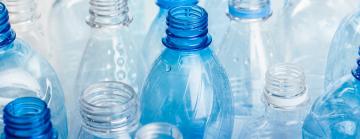SLAC researchers join effort to make plastic more recyclable
Scientists at the Stanford Synchrotron Radiation Lightsource will study plastics and biologically-motivated processes that break them down in hopes of finding more efficient ways to “upcycle” them.
Plastic is versatile, lightweight, cost effective and durable, which is why we use so much of it and why demand for plastics continues to rise. Unfortunately, they can also be quite hard to recycle into similarly durable materials in an efficient way. As a result, much of what we put in recycling bins ends up incinerated or dumped in a landfill.
Now, to help do something about that, researchers at the Department of Energy’s (DOE’s) SLAC National Accelerator Laboratory are joining the Bio-Optimized Technologies to Keep Thermoplastics out of Landfills and the Environment, or BOTTLE, consortium. Made up of researchers from several national labs and universities, the consortium is turning to biologically inspired chemistry and materials to make plastic recycling more cost effective — and ultimately tackle a pressing environmental issue.
“As humans, we were blind to the real problems of plastic waste,” said Simon Bare, a distinguished staff scientist at SLAC’s Stanford Synchrotron Radiation Lightsource (SSRL) who is working with SSRL scientists Chris Tassone and Ritimukta Sarangi to organize SLAC’s efforts with BOTTLE.
“Now,” Bare said, “the idea is that we can upcycle plastic – we can turn it into new products with higher value – instead of throwing it away.”
One key issue BOTTLE is working on is how to use catalysts, ranging from enzymes to nanoparticles, to break plastic into its base units – ideally, individual molecules that could be reconstituted into high-quality plastics. Right now, Tassone said, there are very few catalysts capable of doing so, but over the last year, during BOTTLE’s seed phase, the group found a several that might do the job.
When BOTTLE put out a call for proposals to expand its efforts, Tassone, Sarangi and Bare realized they had an opportunity to help in a key area: With the wide range of techniques and expertise available at SSRL, they could help figure out how to improve plastics and processes developed by other BOTTLE team members.
For instance, SSRL scientists could use X-ray scattering methods to better understand how plastic polymers are structured and what different catalysts do to those polymers. Structural molecular biology techniques could reveal why particular enzymatic catalysts work better than others. And X-ray operando approaches would allow scientists to watch those catalysts in action to understand how they break plastic molecules apart.
“That’s what’s so cool about SSRL. We have this broad team, and we can think about how we can use all our tools to get a holistic picture of how polymer breakdown and upcycling works,” Sarangi said.
Ultimately, the hope is to feed what SSRL scientists find into designing more easily upcyclable plastics and cost-effective methods for upcycling them, Tassone said, so that they become economically viable. “We want to get these types of processes out to industry, so they can work on the megaton scale,” he said, making it possible to recycle most of what we currently throw out and perhaps even clean up the mess we’ve made.
BOTTLE is led by DOE’s National Renewable Energy Laboratory and includes members from DOE’s Argonne National Laboratory, Los Alamos National Laboratory and Oak Ridge National Laboratory; Colorado State University; the Massachusetts Institute of Technology; Montana State University; Northwestern University; and the University of Portsmouth. The research is funded by the Department of Energy’s Bioenergy Technologies Office and Advanced Manufacturing Office within the Office of Energy Efficiency and Renewable Energy SSRL is a DOE Office of Science user facility.
Contact
For questions or comments, contact the SLAC Office of Communications at communications@slac.stanford.edu.
SLAC is a vibrant multiprogram laboratory that explores how the universe works at the biggest, smallest and fastest scales and invents powerful tools used by scientists around the globe. With research spanning particle physics, astrophysics and cosmology, materials, chemistry, bio- and energy sciences and scientific computing, we help solve real-world problems and advance the interests of the nation.
SLAC is operated by Stanford University for the U.S. Department of Energy’s Office of Science. The Office of Science is the single largest supporter of basic research in the physical sciences in the United States and is working to address some of the most pressing challenges of our time.
(Image credit: iStock)





